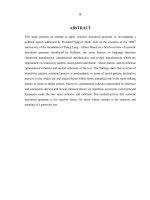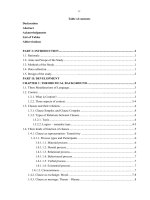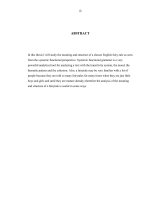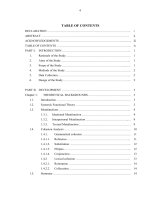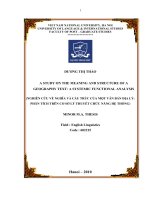nominal groups in selected chapters from pride and prejudice by jane austen a systemic functional analysis = cụm danh từ trong một số chương từ kiêu hãnh và định kiến jane austen
Bạn đang xem bản rút gọn của tài liệu. Xem và tải ngay bản đầy đủ của tài liệu tại đây (725.6 KB, 71 trang )
VIETNAM NATIONAL UNIVERSITY - HANOI
UNIVERSITY OF LANGUAGES & INTERNATIONAL TUDIES
FACULTY OF POST-GRADUATES STUDIES
***********
NGUYỄN THỊ LAN PHƢƠNG
NOMINAL GROUPS IN SELECTED CHAPTERS
FROM “PRIDE AND PREJUDICE” BY JANE AUSTEN:
A SYSTEMIC FUNCTIONAL ANALYSIS
CM DANH T TRONG MT S CHƢƠNG
TƢ
̀
“KIÊU HA
̃
NH VA
̀
ĐI
̣
NH KIÊ
́
N” CU
̉
A JANE AUSTEN:
PHÂN TI
́
CH THEO QUAN ĐIÊ
̉
M NGƢ
̃
PHA
́
P CHƢ
́
C NĂNG
M.A. MINOR PROGRAMME THESIS
Field: English Linguistics
Code: 60220201
HANOI – 2013
VIETNAM NATIONAL UNIVERSITY - HANOI
UNIVERSITY OF LANGUAGES & INTERNATIONAL TUDIES
FACULTY OF POST-GRADUATES STUDIES
***********
NGUYỄN THỊ LAN PHƢƠNG
NOMINAL GROUPS IN SELECTED CHAPTERS
FROM “PRIDE AND PREJUDICE” BY JANE AUSTEN:
A SYSTEMIC FUNCTIONAL ANALYSIS
CM DANH T TRONG MT S CHƢƠNG
TƢ
̀
“KIÊU HA
̃
NH VA
̀
ĐI
̣
NH KIÊ
́
N” CU
̉
A JANE AUSTEN:
PHÂN TI
́
CH THEO QUAN ĐIÊ
̉
M NGƢ
̃
PHA
́
P CHƢ
́
C NĂNG
M.A. MINOR PROGRAMME THESIS
Field: English Linguistics
Code: 60220201
Supervisor: Dr. Đỗ Tuấn Minh
HANOI – 2013
i
DECLARATION
I, Nguyê
̃
n Thi
̣
Lan Phương , hereby declare that this minor thesis is the result
of my own research and I have not been submitted anywhere for any award. All
sources of information in this study which is not my own work has been identified
and acknowledged. I also state that the thesis has not, wholly or in part, been
submitted for any degree to any other universities or substitutions.
Nguyê
̃
n Thi
̣
Lan Phƣơng
October, 2013
ii
ACKNOWLEDGEMENTS
I would like to express the deepest appreciation to Dr. Đỗ Tuấn Minh, my
supervisor, for invaluable and constructive guidelines during the planning as well as
the development of this research work.
My heartfelt thanks also go to my family, friends and colleagues whose
encouragement and support have made the completion of my thesis possible.
iii
ABSTRACT
This study provides an insight into the selected nominal groups in “Pride and
Prejudice”, one of the most enduringly popular novels in the English language, by
Jane Austen.
in the light of Systemic Functional Grammar.
While the make-up of the nominal groups in the original work is revealed and
described, an analysis of English nominal groups and Vietnamese equivalents in the
two Vietnamese versions by Diệp Minh Tâm and Thu Trinh is also presented.
Upon completion of the research, the findings reflect the similarites and differences
in the treatment of the nominal groups between the two translators, based on which
some implications for potential translators of this masterpiece are produced.
iv
TABLE OF CONTENTS
DECLARATION
i
ACKNOWLEDGEMENTS
ii
ABSTRACT
iii
TABLE OF CONTENTS
iv
PART I: INTRODUCTION
1
1. Rationale for the study
1
2. Scope and objective of the study
2
3. Research methods
2
4. Design of the study
3
PART II: DEVELOPMENT
4
CHAPTER I: THEORETICAL BACKGROUND
4
1. Schools of grammar
4
1.1 Traditional grammar
4
1.2 Systemic Functional Grammar
4
2. Basic notions
5
2.1. Noun
5
2.2. Noun phrases in Traditional Grammar and Nominal groups in SFG
5
3. Noun phrases in Traditional Grammar
5
3.1. Basic noun phrase
6
3.2. Complex noun phrase
7
4. Nominal groups in Systemic Functional Grammar
7
v
4.1. Terminology in Systemic Functional Grammar in contrast to
Traditional Grammar
7
4.2. Structure of nominal groups
8
4.2.1. Deictic
9
4.2.2. Numerative
9
4.2.3. Classifier and Epithet
9
4.2.4. Thing
10
4.2.5. Qualifier
10
5. Nominal groups in Vietnamese
12
6. Similarities and differences between Vietnamese nominal groups and
English nominal groups
14
7. “Pride and Prejudice” & Analytical background
15
7.1. About the author Jane Austen
15
7.2. Pride and Prejudice
16
7.3. Vietnamese translated versions
17
7.4. Previous studies
17
CHAPTER II: DATA COLLECTION AND ANALYSIS
18
1. Data collection
18
2. Data analysis
19
2.1. Features of Nominal groups in “Pride and Prejudice” by Jane
Austen
19
2.1.1. Overview on the nominal groups in “Pride and Prejudice” in the
selected chapters
19
2.1.2. Pre-modification: A look at Deictic, Numerative, Epithet and
Classifier
20
2.1.3. Qualifier
22
2.1.3.1. Minor process as Qualifier
22
vi
2.1.3.2. Major process as Qualifier
22
2.1.3.3. Multiple embeddings in Qualifier
23
2.1.3.4. Multiple Qualifier
24
2.1.4. Nominal group complex in Minor process
25
2.2. Treatment of Nominal groups in Vietnamese translated versions
26
2.2.1. Treatment of nominal groups as a whole
26
2.2.2. Treatment of the Head/Thing
29
2.2.3. Treatment of Pre-modification
33
2.2.4. Treatment of Qualifier
36
2.2.4.1. Treatment of prepositional phrases as Minor process
36
2.2.4.2. Treatment of Major process
39
PART III: CONCLUSIONS
42
REFERENCES
45
APPENDIX
I
1
PART I: INTRODUCTION
1. Rationale for the study
A fundamental shift in linguistic research from focusing on forms to
exploring both forms and functions has been seen in recent years by linguistics.
The big change represents an attempt of viewing and treating language as a
communication activity rather than blocks of isolated grammar sets. With the
introduction of Systemic Functional Grammar by Halliday, the functional
exploration and analysis of texts helps us understand the way texts work by
applying what we know about the meaning of grammatical resources.
When it comes to syntactic analysis, noun phrases are considered to be
common cross-linguistically, which may result in the fact that they seem to earn
the place of the most frequently occurring phrase type. The same case applies to
literary works where a huge distribution of noun phrases, termed as “nominal
groups” by Halliday, are observed. One of the most worldwide famous literature
masterpieces, “Pride and Prejudice” by Jane Austen, long lives with readers not
only because of the excellent plot. The considerable attention to the linguistics of
the timeless novel has always been paid by scholars across the nations. One of the
most loved linguistic aspects debated is the abundance of sophisticated nominal
groups exploited in this work of art. As a consequence, loads of researches have
been conducted to make an analysis of the aforementioned topic.
Boasting the vivid and superb language, “Pride and Prejudice” earns a huge
popularity in Vietnam and the work, therefore, enjoys the circulation of the so far
two different versions of translation. Since their introduction, both of the versions
by Diệp Minh Tâm and Thu Trinh have gained noticeable success in winning the
hearts of the keen readers.
The author would like to conduct a study to explore the use of nominal
groups in the novel in the light of Systemic Functional Grammar and also an
analysis of their Vietnamese equivalents in the two Vietnamese translation
versions to examine whether there exists any differences between the two versions
2
due to perceptions of life and culture as well as to bring a fresh investigation into
the bicentenary literary treasure.
2. Scope and objective of the study
As the title of the study suggests, the thesis will be conducted with a view to
describing the nominal groups in selected chapters, owing to the small scale, in
“Pride and Prejudice” following the framework of Systemic Functional Grammar
by Halliday. Besides, a contrastive analysis of the nominal groups and their
Vietnamese equivalents in the two Vietnamese translation versions are provided in
the hope that readers may have a better understanding and their own judgment over
which version gains more success in transmitting the message of the author in the
literary work.
The research questions, therefore, are posed as follows:
- What are nominal groups?
- How are the nominal groups in selected chapters in “Pride and
Prejudice” structured in the light of Systemic Functional Analysis?
- What changes are made to the structure of the English nominal groups
in the two translated versions?
- What are the similarities and differences between nominal groups in
English and their equivalents in the two Vietnamese versions?
3. Research methods
As the research is undertaken with the aim of investigating the nominal
groups in the novel, the descriptive and contrastive analysis with the qualitative
data will be employed. Also, the Vietnamese equivalents in the two translation are
put together for the purpose of comparison in terms of structure. In this way, the
use of nominal groups in this work will be extensively investigated while the
Vietnamese equivalents are correspondingly reviewed.
4. Design of the study
The first part of the study offers readers a quick look at the study with the
aims and methodology.
3
Part II , the Development, provides an overview of the theoretical foundation
to this research, the analytical background where the literary work is introduced
together with its translated versions as well as the data analysis.
The ending chapter is in charge of the conclusion, which presents the
summary of the findings and directions for future research.
4
PART II: DEVELOPMENT
CHAPTER I: THEORETICAL BACKGROUND
1. Schools of grammar
1.1. Traditional grammar
It is common knowledge that every language has a grammar, which is
understood as the rules for constructing words and sentences. As a consequence,
the fact that grammar is taught throughout the school system leads to it being
standardized. Amongst the schools of grammar that are known to linguists
around the world is the Traditional grammar, “the body of grammatical work
that was done in Europe and America before the rise of modern linguistics in the
twentieth century” (Trask & Stockwell, 2007). The work of the grammarians at
this time is still believed to form the foundation of modern grammar, though a
number of changes and extensions have been introduced.
1.2. Systemic Functional Grammar
Malmkjer (2010) in “The Linguistics Encyclopedia” provided readers with an
overview of Systemic Functional Grammar (SFG) as an approach to language
which emerges from British and European language studies, particularly the
work of J.R. Firth, and is consolidated by Halliday in 1985, 1994 and Halliday
and Matthiessen in 2004.
Based on the groundwork of Firth for somewhat social approach to language,
Halliday developed the aforementioned idea in the very distinctive directions of
his own. It is revealed in “Longman Dictionary of Language Teaching and
Applied Linguistics” by Richards & Schmidt (2010) that language, in his
viewpoint, is seen as “a resource used for communication in social contexts
rather than as an abstract formal system”. This book also clarifies that the word
“systemic” refers to the view of language as a network of interrelated systems
5
while “functional” shows that the approach is concerned with the choices people
make with a view to exchanging meanings through language.
Crystal (2008) also equipped readers with the term “Hallidayan” to refer to any
linguistic principles of this British linguist. It is noteworthy that the application
of Hallidayan ideas has been widespread, especially in text analysis, stylistics
and language acquisition.
2. Basic notions
2.1. Noun
According to Trask and Stockwell (2007), traditional grammarians failed to
define this part of speech when describing it as „the name of a person, place or
thing‟. However, in “Dictionary of Linguistics and Phonetics” by Crystal (2008),
this vagueness no longer exists once nouns are construed as “items which
display certain types of inflection (e.g. of case or number), have a specific
distribution (e.g. they may follow prepositions, but not modals), and perform a
specific syntactic function (e.g. as subject or object of a sentence). It is also
added that nouns are generally classified into common nouns and proper nouns,
and analyzed in terms of number, gender, case and countability”.
2.2. Noun phrases in Traditional Grammar and Nominal groups in SFG
The constructions into which nouns most commonly enter, and of which they are
the head word, are generally called Noun phrases or nominal groups. The
structure of a noun phrase is featured minimally by the noun while the
constructions preceding and following the noun are put under the name of pre-
modification and post-modification, which would be discussed in the next parts.
(Crystal, 2008)
3. Noun Phrases in Traditional Grammar
6
Traditional Grammar made a big advance in grammatical study during the
twentieth century. The contemporary work now seems noticeable with
distinguished names, among which are Randolph Quirk and his colleagues,
whose English grammar series are very much known. As a result, this study
would like to revisit the background of noun phrases from the point of view of
Quirk and Greenbaum (1987).
In their book, A University Grammar of English, noun phrases are believed to
typically function as subject, object, complement of sentences and as
complement in prepositional phrases, as exemplified in these following
sentences:
(a) The girl
Is Mary Smith
(b) The pretty girl
(c) The pretty girl in the corner
(d) The pretty girl who became
angry
In this approach, noun phrases are subclassified into basic noun phrases and
complex noun phrases.
3.1.Basic noun phrase
The basic noun phrases are characterized as nouns with articles or other closed-
system items that can occur before the noun head; those are the Determiners as
belows:
All these 10
Students
Determiners
Head noun
7
As its name suggests, a determiner “determines” the precise meaning of the
noun and may come into three types: pre-determiners (e.g. all, both, half),
central determiners which may be the possessive, or articles, etc.) and post-
determiners (e.g. cardinal numbers, ordinal numerals, and quantifiers).
3.2. Complex Noun phrase
Take an example of a long sentence with the aforementioned information about
the girl in the previous part:
The pretty girl standing in the corner who became angry is Mary Smith.
It is easily seen that the complicated structure of the sentence is reshaped
because of the complex noun phrase. Then it comes to how a complex noun
phrase could be realized:
Complex Noun Phrase
Pre-Modification
Head Noun
Post-modification
Comprising all the items
placed before the head –
remarkably nouns and
adjectives
Around which the other
components cluster and
which dictates concord
and other kinds of
congruence with the rest
of the sentence outside the
noun phrase
In which reside all the
items after the head –
notably prepositional
phrases, non-finite clauses
and relative clauses
4. Nominal Groups in Systemic Functional Grammar
4.1. Terminology in Systemic Functional Grammar in contrast to Traditional
Grammar
8
It is remarkable that though a “nominal group” is widely accepted as
synonymous to a “noun phrase”, Halliday (1994) drew quite a line between the
term “group” and “phrase”, and argued that a group is a combination of words
built up on the basis of a particular logical relation whereas phrase is a
contraction of a clause. Similarly, the term „nominal‟ denotes a wider class of
phenomena than the term „noun‟, so that is the reason why Halliday adopted the
name. For this study is based on the framework of Halliday and his followers,
“nominal group” would be henceforth employed instead of the term “noun
phrase”.
4.2. Structure of Nominal groups
Halliday (1994) introduced a division in the structure of the nominal group into
two types: experiential and logical. The logical structure is expected to be primarily
concerned with the orders of functional elements while the experiential structure are
under scrutiny to focus on semantic meaning-relations between the head noun and
its surrounding elements.
Halliday‟s classification of the structure of the nominal group would be analyzed
in the example below:
Those
Five
Beautiful
Shiny
Jonathan
Apples
Sitting on the
chair
The make-up of the nominal group is presented in the above example, where the
Head noun is bolded. In the simplest kind, a nominal group may consist of only a
Head. However, in this case provided, the noun does not stand alone; it also
contains modification, which may precede the Head (as the pre-modifier) or follow
the Head (as Post-modifier).
9
Those
Five
Beautiful
Shiny
Jonathan
Apples
Sitting on the
chair
Pre-modifier
Head
noun
Post-modifier
The following part would provide a thorough insight into the structure of nominal
groups in SFG by introducing the functional elements.
4.2.1 Deictic
This term derives from the Greek word for „pointing‟. In this manner, the
Deictic function is realized by determiners (e.g. this, that, these, those, the, etc.)
or possessive nouns or pronouns, such as „Sony‟s‟ in „Sony‟s latest model‟, or
„your‟ in „your home‟.
Besides, there may be a second Deictic element in the nominal group to “add
further to the identification of the subset”. (Halliday, 2013). This type of Deictic
is believed to specify a subset of the class of „thing‟ by referring to its similarity
or dissimilarity to other designated subset.
4.2.2. Numerative
In the clause above, the numerative is „five‟. This is to say that numeratives can
be realized by such numerals. This functional element may be realized either by
a quantifying numeral (with exact number like “two” or inexact ones such as
“many”) or by the ordering numerals (e.g. “second”).
4.2.3. Classifier and Epithet
The word „Jonathan‟ functions as a Classifier with a view to putting the
modified item into a subclass of such items. Another case in point may be: „bus‟
in „bus station‟ in which the Classifier „bus‟ is put before the item „station‟ to
distinguish it from other types of stations.
10
Yet, the word „beautiful‟ and „shiny‟ may serve another purpose in the
mentioned nominal group. These features may not classify the items into
subtypes; they tell us some other things about the characteristics of those apples.
Hence, those are labelled Epithet. However, it is of great importance to put the
nominal groups into context; otherwise, this would blur the line between
Classifier and Epithet.
It is also remarkable that Epithet may fall into two types: experiential Epithet,
which indicates the quality as an objective property of itself, or interpersonal
Epithet which reflects or expresses the speaker‟s subjective attitudes towards it.
Here are some examples:
Then he saw it – a large red feather barely
sticking out of the straw mat.
Experiential Epithet
I knocked on the door and an awfully sweet lady
came.
Interpersonal Epithet
4.2.4. Thing
When it comes to the head noun of the nominal group, Halliday termed it the
Thing. Yet, it is also revealed in his book that there is one very common type of
nominal group where Head and Thing do not coincide. This case is featured by
the „measure‟ of something.
A
Pack
Of
Cards
Numerative
Thing
Pre-modifier
Head
Post-modifier
4.2.5. Qualifier
11
While the part preceding the Head may be words or word complexes, what
follows the Thing is either a phrase or a clause, which are often referred to as the
Qualifier. For most cases, Qualifier is featured with embedded clauses. With the
function of characterizing the Thing, Qualifier may be a major process (i.e. a
relative clause) or a minor one (i.e. a prepositional phrase) in which the thing
would be a participant though directly or not.
The most special thing about Qualifier is that the majority of Qualifier is rank-
shifted. It is to say that the Qualifier is of a higher rank than, or at least
equivalent to that of the nominal group, which is addressed as „embedded” in
formal grammar.
Bloor & Bloor (2004), in their book “The Functional Analysis of English: A
Hallidayan Approach” provided a number of examples of nominal groups
analyzed in the light of Systemic Functional Grammar:
Pre-modifier
Head
Post-
modifier
Deictic
Numerative
Epithet
Classifier
Thing
Qualifier
These
Two
New
Light
Switches
The
Two
Domestic
Flights
Available
The
Many
Large
Oil
Companies
In operation
Several
Dirty
Ones
The
Complete
Dismantling
Of the
gearbox
The
Keyboard
Layouts
12
An
Careful
Study
Of this
matter
an
Effective
Prediction
scheme
To sum up, the structure of the nominal group might be illustrated as follows:
Deictic
Deictic 2
Numerative
Epithet
Classifier
Head
(Thing)
Qualifier
Determiner
Adjective
Numeral
Adjective
Noun or
Adjective
Noun
Relative
clause or
Preposition
phrase
5. Nominal Groups in Vietnamese
About the structure of Vietnamese Nominal Groups, In his book on Vietnamese
grammar, Nguyen Tai Can (1997) held the view that the structure of
Vietnamese groups is described with front elements, a noun nucleus, and the end
elements, giving the following examples to provide readers with a better
understanding:
Front elements
Nucleus
End elements
Ba
Người
Này
Tất cả những cái
Chủ trương
Chính xác đó
13
Another Vietnamese grammarian, Diep Quang Ban (2005) claimed that the
order of the elements in a nominal group could be clearly presented in this chart:
Tất cả
Những
Cái
Con mèo
Đen
Ấy
-3
-2
-1
0
1
2
It is remarkable that noun nucleus in Vietnamese nominal groups are notably
characterized with a classifier. From this feature, it is obviously seen that this
element, though sharing the name with the Classifiers in nominal groups in the
light of Systemic Functional Grammar, bears the different function. Tuong Hung
Nguyen (2004) carefully examined the use of Classifiers in the Vietnamese
language. Though a classifier is used with a noun, a nominal group may not
contain a classifier. It, therefore, is indicated in the study the numerative cannot
precede the noun without “an intervening classifier” as shown below:
Tôi mua cuốn sách
Cuốn: Classifier
Tôi mua sách
No classifier: Acceptable
Tôi mua ba cuốn sách
Tôi mua ba sách
No classifier: Unacceptable
The research also claimed that classifiers in the Vietnamese language form a
closed lexical class. The choice over which classifier to go with the noun relies
on the semantic features of the classified nouns.
Inanimate
Non-human
Human
Cái bàn
Con cá
Người bạn
14
Classifier: cái, Noun: bàn
Classifier: con, Noun: cá
Classifier: người, Noun:
bạn
Cái kéo
Classifier: cái, Noun: kéo
Con chó
Classifier: con, Noun: chó
Người chị
Classifier: người, Noun:
chị
Also, they are mutually exclusive; that means they do not co-occur in one same
nominal group as follows:
Cái cây thước
Not: cây cái thƣớc
To bring a thorough formulation for a nominal group in Vietnamese, Le Thi
Hong Phuong (2011) provides the following chart:
Pre-modification
Head
Post-modification
Totality
(thành tố
phụ chỉ tổng
lượng)
Article
Classifier
(loại từ)
Noun
Attributive
modifier
(thành tố phụ nêu
đặc trưng miêu tả)
Demonstrative
(thành tố phụ chỉ
định)
Tất cả
những
con
mèo
đen
ấy
6. Similarities and differences between Vietnamese nominal groups and
English nominal groups
Nguyen Kim Phung (2009) clearly asserted that the most distinctive feature
which separates Vietnamese nominal groups from English ones is that in the
15
language of Vietnamese, the head noun does not indicate number as English
counterparts. While English head nouns demand a morpheme “s” or “es” to
represent plurality, Vietnamese equivalents do not need to make any changes in
the form.
Though the structure of Vietnamese noun phrases is carefully examined by Le
Thi Hong Phuong (2011), she seemed to introduce an incomplete contrastive
analysis when pointing out just two main differences between the two languages
in word order, which emphasizes the position of Adjective after the head, and
the usage of classifiers as a specific lexical class.
Cao Thi Thu Giang (2005), while putting the two language systems together,
investigated the similarities and differences of the nominal groups in terms of
numerals and quantifiers, adjectives and nouns, relative clauses, non-finite
clauses and prepositional phrases as post-modification. The first and second
matters to be discussed seem to be easily observed. Yet, the study impressively
underlines that in the case of non-finite clauses, they tend to be much more
common in English than in Vietnamese whereas the passive voice with “bị” and
“được” are employed in Vietnamese though the Vietnamese people have a
preference for the active voice. Similarly, when it comes to prepositional phrases
as post-modification, it is highlighted that the genitive “của” in Vietnamese
bears the tendency to be omitted, such as in the following case:
A boy of talent
Một cậu bé (của) tài năng
7. Pride and Prejudice - Analytical Background
7.1. About the author Jane Austen
Jane Austen, an accomplished writer whose writings are deeply rooted in the
years of her youth. She was born on December 16, 1775 in the English county of
16
Hampshire, west of London. She was the seventh of eight children who were
brought up by her father, a clergyman and her mother who came from a family
of landed gentry and clergy. Encouraged by her parents to cherish her own
literary efforts, she kept writing long fictional pieces, and finally finished her
first novel at the age of 19. Her most noticeable novels are Sense and Sensibility
(1811), Pride and Prejudice (1813), Mansfield Park (1814), Emma (1815),
Northanger Abbey (1817) and Persuasion (1817), all of which primarily dealt
with the lower nobility, a leisured class in the eighteenth century.
In terms of language use, she possessed the sharp and sarcastic wit which slowly
built up the vivid image of everything appearing in her novels. Austen scholar
Le Faye once described her gift in creating “the sensation that we are visiting
genuine places and joining in the lives of genuine people” (Le Faye, 2006).
Though considered as a well known writer, Jane Austen is believed to polarise
her readers. It is to say that they either adore her with big affection or
completely abhor her. In evaluating Jane Austen, Charlotte Bronte (1848)
acknowledged her as “a great artist without poetry” while Mark Twain (1898)
refused to have her books in the library with the reason that whenever he read
her book, he was in the inclination to “dig her up and hit her over the skull with
her own shin-bone”. Regardless of diverse tastes, she is considered the writer of
merit and remains a tremendous influence in the development of the English
literature.
7.2. Pride and Prejudice
Initially named “First Impressions”, then “Dignity and Perception” before
finally transformed into “Pride and Prejudice”, this first novel of Jane Austen
since its advent soon attracted a wide range of audience, and earned Jane her
place as one of the most influential writers of all time. Portrayed as a gem of
novels, it came second in “The Big Read” by BBC (2003) and was the runner-up
17
“UK‟s best loved book”. It is to say that “Pride and Prejudice” is the work that
gained her popularity in her time and enhances her reputation as her most
widely-read book.
2013 is the year which marks the bicentenary of this literary treasure of every
man in the world. 200 years passing raises the question whether the image of
Miss Elizabeth Bennet is now out of date in the era of quick-paced lives. Yet,
this love story, though centuries old, is eternally fresh with the admiration from
readers of generations who have been in the consensus that “Pride and
Prejudice” will reign as one of the world‟s greatest novels as well as Jane
Austen‟s best work. One firm thing to say is that this novel will never be dusted.
7.3. Vietnamese translated versions
Thanks to the popularity of the literary work in Vietnam, there have been two
translated versions in circulation. The novel is mostly introduced to Vietnamese
readers with the 600-page translated version “Kiêu Hãnh và Định Kiến” by Diệp
Minh Tâm, a member of Vietnamese writer Associations in 2003. In contrast,
little attention has been paid to the second translated version which is known
under the name of “Kiêu Hãnh và Thành Kiến” by Thu Trinh, an overseas
Vietnamese, in 2008.
7.4. Previous studies
As a literary treasure of mankind, “Pride and Prejudice” earns a credited place in
the literature of the world. It is, therefore, obvious that a big number of studies
have investigated into a wide range of topics about this novel. Teachman (1997)
debated the social issues in that time of the work, such as the eighteenth-century
views of marriage or how to choose a marriage partner. Love and marriage
continue to be examined in Anne Crippen- Ruderman‟s work (1990). Hundreds
of reliable websites, among which are Neboliterature and Sparknotes, provide



